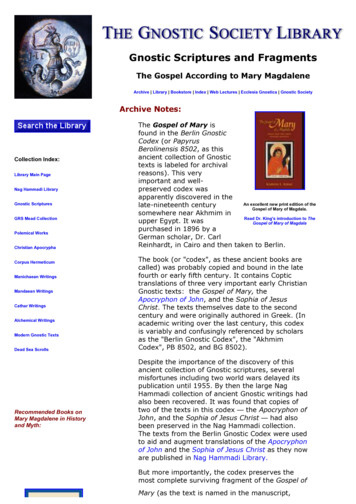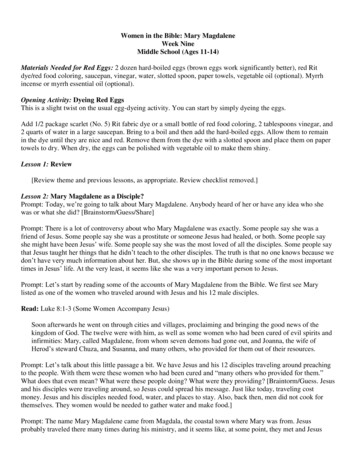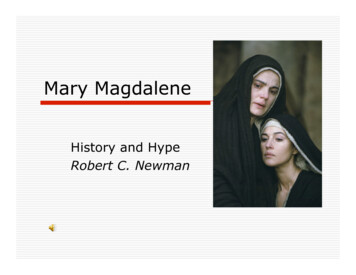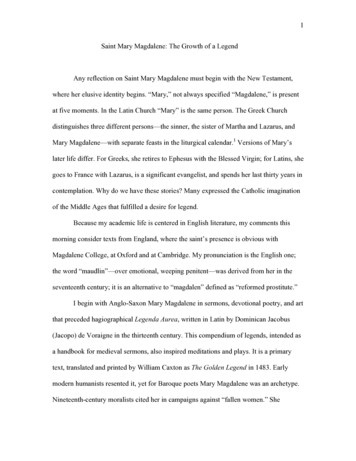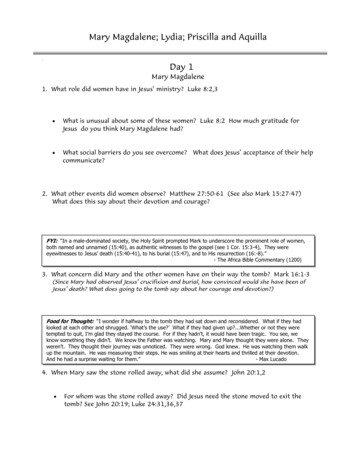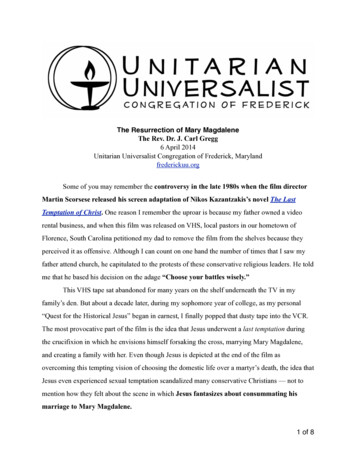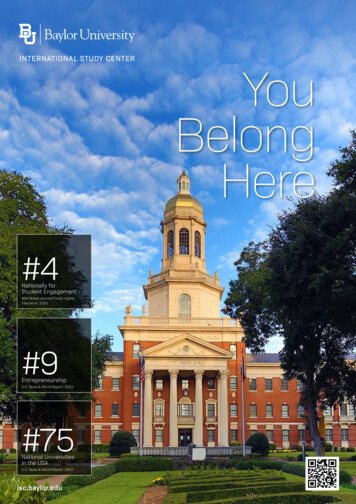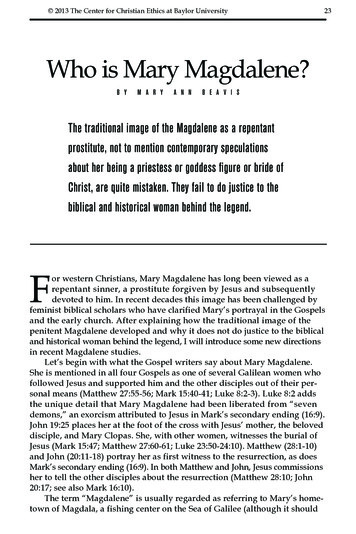
Transcription
23Who is Mary Magdalene?B yM a r yA n nB e a v i sThe traditional image of the Magdalene as a repentantprostitute, not to mention contemporary speculationsabout her being a priestess or goddess figure or bride ofChrist, are quite mistaken. They fail to do justice to thebiblical and historical woman behind the legend.For western Christians, Mary Magdalene has long been viewed as arepentant sinner, a prostitute forgiven by Jesus and subsequentlydevoted to him. In recent decades this image has been challenged byfeminist biblical scholars who have clarified Mary’s portrayal in the Gospelsand the early church. After explaining how the traditional image of thepenitent Magdalene developed and why it does not do justice to the biblicaland historical woman behind the legend, I will introduce some new directionsin recent Magdalene studies.Let’s begin with what the Gospel writers say about Mary Magdalene.She is mentioned in all four Gospels as one of several Galilean women whofollowed Jesus and supported him and the other disciples out of their personal means (Matthew 27:55-56; Mark 15:40-41; Luke 8:2-3). Luke 8:2 addsthe unique detail that Mary Magdalene had been liberated from “sevendemons,” an exorcism attributed to Jesus in Mark’s secondary ending (16:9).John 19:25 places her at the foot of the cross with Jesus’ mother, the beloveddisciple, and Mary Clopas. She, with other women, witnesses the burial ofJesus (Mark 15:47; Matthew 27:60-61; Luke 23:50-24:10). Matthew (28:1-10)and John (20:11-18) portray her as first witness to the resurrection, as doesMark’s secondary ending (16:9). In both Matthew and John, Jesus commissionsher to tell the other disciples about the resurrection (Matthew 28:10; John20:17; see also Mark 16:10).The term “Magdalene” is usually regarded as referring to Mary’s hometown of Magdala, a fishing center on the Sea of Galilee (although it should
24Women in the Biblebe noted that there is no first-century reference to a town by that name). Aminority view is that Magdalene (“Tower”) is honorific, referring to her statusas a beacon of faith (St. Jerome, Letter to Principia 127, 255). Her importanceis signified by the fact that in lists of female disciples, she is always mentionedfirst (Matthew 27:56, 61; 28:1; Mark 15:40, 47; 16:1; Luke 8:2-3; 24:10).a case of Mistaken identityThe Gospel portrait of Mary Magdalene as disciple, supporter andproclaimer of the good news of Jesus bears little resemblance to the westerncultural stereotype of the penitent sinner. The notion that she led a sinfullife before she met Jesus seems to be the result of confusion between anunnamed woman, identified as “a sinner,” who anoints Jesus’ feet in Luke7:36-50, and another Mary, the sister of Martha and Lazarus of Bethany,who anoints Jesus’ feet when he is dining at their home (John 12:1-8). Thetwo women are described in very different terms: Luke’s “sinner” appearsuninvited at a dinner party in Capernaum (Luke 7:1) in the house of a Pharisee(Luke 7:36). The point of the story is the woman’s faith and the forgiveness ofher sins (7:47-50). In John’s story, which takes place in Bethany, Mary isidentified as a beloved friend of Jesus (11:5) who anoints Jesus in her brother’shome (12:1) in gratitude for the raising of Lazarus, and Jesus connects heract of devotion with his own burial (12:7).Although all four Gospels contain stories of women who anoint Jesus (seeMark 14:3-9; Matthew 26:6-13), none of them is identified as Mary Magdalene.However, there are several references in post-biblical tradition to the sistersMartha and Mary of Bethany visiting the tomb and meeting with the risenJesus, which led some early Christians to conclude that Mary Magdalene andMary of Bethany were the same person.1 Eventually, the composite “Mary”figure was expanded to include the anonymous sinner of Luke 7:36-50, whosestory is told immediately before Luke’s listing of Jesus’ women disciples fromGalilee: Mary Magdalene, Joanna, and Susanna (8:2-3). However, it was notuntil 591 that Pope Gregory the Great authoritatively pronounced that Luke’ssinner, Mary of Bethany, and Mary Magdalene were one and the same (Sermon33.1). Although Gregory did not actually call her a prostitute, he interpretedthe “seven demons” of which she had been exorcised as the totality of vices,and asserted that the ointment she used to anoint Jesus’ feet had previouslybeen used by her to perfume her body for sensual purposes. Subsequently,the legend of Mary Magdalene, the sister of Martha and Lazarus, as a beautiful,vain, and lustful young woman saved from a life of sin by her devotion toJesus became dominant in western (Catholic) Christianity, although the eastern(Orthodox) church continued to regard Mary Magdalene and Mary of Bethanyas distinct saints, and identified neither with Luke’s sinner.The Gnostic MaryBoth academic scholarship and popular culture have made startlingclaims about the role of Mary Magdalene in a movement in early Christianity
Who is Mary Magdalene?25known as Gnosticism (from the Greek word for “knowledge”). AlthoughGnostics varied in their doctrines and practices, they were unified by thebelief that knowledge or insight into the true nature of the human soul andits relationship to God was the key to salvation. Some Gnostics were moreopen to female leadership, and to female images of the divine, than otherancient Christians.There are, in fact, several Gnostic documents that portray “Mary,” sometimes specified as “Mary Magdalene,” as a preeminent Gnostic, an enlightenedwoman who understands the teachings of the Savior better than the maledisciples, and who was especially loved by him (e.g., The Gospel of Mary, TheGospel of Philip, The Sophia of Jesus Christ, and Pistis Sophia). For example, theGospel of Philip 63 calls Mary Magdalene Jesus’ “companion” whom he lovedmore than the other disciples; the Dialogue of the Savior 139-140 refers toMary as one who understood everything and who showed the Revealer’sgreatness; Pistis Sophia 19 extols Mary’s greatness and spiritual purity.Although Mary’s authority, understanding, and relationship to Christare highlighted in these documents, the notion that “Mary Magdalene” wasa Gnostic heroine needs qualification. In fact, many of the references to theGnostic Mary do not actually refer to her as “Magdalene”; this is even thecase in The Gospel of Mary. The Gnostic Mary is actually a composite figurewho partakes in characteristics of both Mary Magdalene—faithful discipleand resurrection witness—and Mary of Bethany, who learns at the feet ofJesus (Luke 10:38-42), is beloved by him (John 11:5), and who is commendedby him (Luke 10:42; John 12:7-8). Much as the composite Mary functioned asa model of faithfulness and (later) repentance for non-Gnostic Christians,the Gnostic Mary was theideal enlightened disciple.Unfortunately, while the roleThe legend of Mary Magdalene as a beautiful,of the biblical Magdalene inthe “Mary” figure has beenvain, and lustful young woman saved from a lifeemphasized by scholars (forinstance, in books like Theof sin by her devotion to Jesus became dominantGospel of Mary of Magdala),the qualities of Mary ofin western Christianity after the sixth century.Bethany in the characterhave been overlooked.2The Wife of Jesus?Perhaps the most sensational claim that has been made about MaryMagdalene is that she was not only a faithful disciple and teacher, but thatshe was actually married to Jesus, and that she secretly bore his child, anheir to the messianic dynasty. This idea has not been taken seriously by mostacademics, but it has been disseminated by works of popular scholarshipsuch as Baigent, Lincoln, and Leigh’s Holy Blood, Holy Grail and a series of
26Women in the Biblebooks by Margaret Starbird. 3 Even more influentially, Dan Brown’s novelThe Da Vinci Code (2003) and the ensuing film presented the speculationsof these authors as historical fact. Subsequently, novelists such as KathleenMcGowan have published similar works of fiction. Several of these bookspresent Jesus and Mary Magdalene as a model of equality and mutualityfor married couples.The theory that Jesus and Mary Magdalene were husband and wife isdeveloped differently by the various authors. Among the data often used tosupport their conjectures are the Gnostic references to Jesus’ particular lovefor Mary (Gospel of Philip 63; Gospel of Mary 10). However, as noted above, thetradition of the Savior’s love for the Gnostic Mary is traceable back to John11:5, which mentions that Jesus loved Martha, her sister (Mary of Bethany),and Lazarus. Indeed, the love of Jesus for all his brothers and sisters is atheme of the Gospel of John (e.g., 13:1, 34, 35; 14:21; 15:9). Another piece ofevidence presented by such writers is a doctrine held by a medieval sectknown as the Cathars (“Pure Ones”), who allegedly taught that Jesus andMary Magdalene were husband and wife. In fact, there are two medievalreferences from southern France—where local Catholics believed that MaryMagdalene was buried—that claim the Cathars taught that Christ and theMagdalene were married. Another medieval source claims that the Catharstaught there were two Christs, one good and one evil, and that MaryMagdalene was the evil Christ’s concubine.4The Cathars were extreme ascetics who preferred celibacy to marriage;they regarded Christ as a purely spiritual being so heavenly that he neverleft paradise, but who manifested on earth (which they regarded as hopelessly corrupt) only through the apostle Paul. Thus, it is unlikely that theCathars viewed the relationship between Jesus and Mary as a paradigm forhuman marriage affirmative of sexuality, or that they believed the couplehad children. Furthermore, these references to Cathar doctrines are fromCatholic witnesses who regarded the Cathars as deplorable heretics, and sowere inclined to present Cathar teachings as bizarre and shocking. In addition,there is evidence that the Cathars had a tendency to interpret biblical andtheological metaphors literally. For example, some Cathars apparentlyinterpreted the theological axiom that the Virgin had conceived Christthrough her ear, referring to her obedience to the divine word, to mean thatshe had actually conceived—and given birth—to Jesus through her earcanal. Possibly, the Cathars similarly literalized romantic French legendsthat emphasized the extravagant love of Mary Magdalene for Jesus, and thewritings of medieval theologians who extolled the spiritual “marriage”between Christ and the Magdalene as a model for cloistered women. Whileit is easy to sympathize with the Cathars, who were brutally exterminatedin the Albigensian Crusade (1209-1229), it is unlikely that their esotericdoctrines shed much light on the historical Mary Magdalene.
Who is Mary Magdalene?27Mary Magdalene and the Sacred FeminineAnother feature of the claim that Mary Magdalene was Jesus’ wife isthe assertion that as Christ’s female counterpart, she symbolizes the femininedivine. For example, the hero of The Da Vinci Code, Robert Langdon, is aHarvard “symbologist” researching a book on “Symbols of the LostSacred Feminine.” The secret of Mary Magdalene is not simply that she isJesus’ wife and the mother of his messianic heir, but that she embodiesthe sacred feminine who to this day is worshipped by her devotees as “theGoddess, the Holy Grail, the Rose, and the Divine Mother.” 5 This sacredmarriage points to the meaning of sex as a “mystical, spiritual act” inwhich “man” achieves the “spark of divinity through union with thesacred feminine,” and, presumably, by which woman unites with thesacred masculine. 6 Surprisingly, for Margaret Starbird, who is a strongproponent of the marriage of Jesus and Mary, and who believes that theywere the parents of a daughter, the royal bloodline hypothesis is “basicallyirrelevant”: she deems much more important its implications for the “fullhumanity” of Jesus, and for the restoration of Mary as the Lost Bride ofChrist, image of the sacred feminine.7Although, from a feminist perspective, the notion of Jesus and Mary asmale and female messianic counterparts may be somewhat appealing, thereis no biblical or historical evidence of any such doctrine. Some Gnosticsrecognized female divine figures, but there is no evidence that Mary“Magdalene” was among them. The references to Cathar belief in a marriedChrist reflect the medieval legend that Mary Magdalene was a sinfulwoman saved from her depravity by Jesus; the witnesses to this Catharbelief state that they identified her with the Samaritan woman at the well(John 4:7-30) and the woman taken in adultery (John 8:2-11). Although theCathars believed in a purely divine Christ, there is no evidence that theyregarded Mary Magdalene as a divinity.This does not mean that metaphors of the divine in feminine terms areforeign to the Bible or to Christianity. Virginia Ramey Mollenkott hasshown that there are many biblical images of God as female—for example,as a mother in labor (Isaiah 42:14), as a nursing mother (Isaiah 49:15), as amidwife (Psalm 22:9-10), as a mother hen (Matthew 23:37; Luke 13:34), or asa bakerwoman (Matthew 13:33; Luke 13:20-21).8 Catholic theologian ElizabethA. Johnson has shown that the figure of divine Wisdom, personified as awoman (Hochmah, Sophia), is a powerful female image of the divine in thebiblical Wisdom literature (especially in Proverbs and the deuteron-canonicalbooks of Sirach and Wisdom of Solomon) that shaped New TestamentChristology (e.g., Matthew 11:19; 1 Corinthians 1:22-24).9 As Jann AldredgeClanton notes, “What Judaism said of personified Wisdom Christian writerscame of say of Christ: the image of the invisible God (Colossians 1:15); theradiant light of God’s glory (Hebrews 1:3); the firstborn of all creation(Colossians 1:15); the one through whom God created the world (Hebrews
28Women in the Bible1:2).”10 Semitic-speaking early Christians often spoke of the Holy Spirit asMother due to the feminine gender of the Hebrew and Aramaic words for“spirit” (ruah, ruha).Mary Magdalene as Priestess?A variant on the claim that Mary Magdalene represents the sacred feminine is the notion that she was a priestess. Barbara Walker’s Women’s Encyclopedia of Myths and Secrets (1983) suggested that Mary was a priestess in apagan temple. A novel by Cythia Kinstler, The Moon under Her Feet (1991),portrays her as having been brought to the Jewish temple to be trained toserve the Queen of Heaven. As an adult high priestess, she marries Jesus toperform the rite of “sacred marriage” with him. Another popular scholar,Lynn Picknett identifies the Magdalene as a priestess of Isis who initiatedJesus into her mysteries through sacred sex.11 Although there is evidencethat in pre-exilic times goddesses were worshipped in the Jerusalem temple(Jeremiah 7:18; 44:17-18, 19, 25; Ezekiel 8:14), there is no trace of any suchpractice in the time of Jesus. It is highly unlikely that a Jewish woman likeMary Magdalene would have honored any deity but the God of Israel.ConclusionFor most of western Christian history, traditions about Mary Magdalenehave not done justice to the biblical figure. Far from merely being a repentantprostitute, the Gospels portray her as a faithful follower and supporter ofJesus, chosen by the risen Christ to proclaim the good news to the otherdisciples. Contemporary speculations about a “sacred marriage” betweenChrist and the Magdalene as his female counterpart are not supported bythe Gnostic and Cathar sources often cited by pop culture writers. Nor areconjectures about a royal bloodline, or notions of Mary Magdalene as apriestess or goddess figure.Another biblical woman whose role has been distorted throughout thecenturies is Mary of Bethany. Not only was she merged early on with MaryMagdalene and subsequently labeled as a prostitute, but her role inextra-biblical tradition as one of the women at the tomb was forgotten inwestern Christianity (although it is remembered in the Orthodox tradition,which regards Mary and Martha of Bethany as among the “Holy MyrrhBearers” at the tomb). Although Mary Magdalene was often called “apostleto the apostles” by medieval theologians, the earliest use of this title isfound in an early Christian homily where it refers to the Bethany sisters,Martha (who is mentioned first) and Mary (Hippolytus of Rome, On theSong of Songs 25.6). As noted above, scholars have virtually overlookedMary of Bethany’s role in the Gnostic figure of Mary “Magdalene.”Although pop culture speculations that Mary Magdalene was Jesus’wife and a manifestation of the female divine find little support in thehistorical evidence, this does not mean that these ideas are insignificant. Thewidespread public fascination with these claims can provide opportunities for
Who is Mary Magdalene?29discussions of many matters relevant to contemporary Christians. Suchissues include the humanity of Jesus, the role of women in ministry, thetheology of marriage, and the meaning of the biblical teaching that bothsexes were created in God’s image (Genesis 1:27). From a feminist Christianperspective, an issue that begs for redress is that after twenty-five years offeminist theology, the significance of Mary of Bethany in early Christianityhas been eclipsed by the enthusiasm for Mary Magdalene. The roles of bothbiblical women as disciples, witnesses, and proclaimers of the reign of Goddeserve equal recognition.NOTES1 For a fuller discussion, see Mary Ann Beavis, “Reconsidering Mary of Bethany,”Catholic Biblical Quarterly 74:2 (2012), 281-297.2 See, for example, Karen L. King, The Gospel of Mary of Magdala: Jesus and the FirstWoman Apostle (Santa Rosa, CA: Polebridge Press, 2003), and Jean Yves Leloup, Gospel ofMary Magdalene (Rochester, VT: Inner Traditions International, 2002).3 Michael Baigent, Richard Leigh, and Henry Lincoln, Holy Blood, Holy Grail (New York:Bantam Dell, 2004 [1982]). Margaret Starbird’s books include The Goddess in the Gospels:Reclaiming the Sacred Feminine (Rochester, VT: Bear & Company, 1998); Mary Magdalene:Bride in Exile (Rochester, VT: Bear & Company, 2005); and The Woman with the AlabasterJar: Mary Magdalen and the Holy Grail (Santa Fe, NM: Bear & Company, 1993).4 For a fuller discussion, see Mary Ann Beavis, “The Cathar Mary Magdalene and theSacred Feminine: Pop Culture Legend vs. Medieval Doctrine,” Journal of Religion andPopular Culture 23: 3 (2012), forthcoming.5 Dan Brown, The Da Vinci Code (New York: Doubleday, 2003), 334.6 Brown, Da Vinci Code, 408.7 See Starbird, Alabaster Jar, 178; Bride in Exile, 142.8 Virginia Ramey Mollenkott, The Divine Feminine: The Biblical Imagery of God as Female(New York: Crossroad, 1983).9 Elizabeth A. Johnson, She Who Is: The Mystery of God in Feminist Theological Discourse(New York: Crossroad, 1992).10 Jann Aldredge-Clanton, In Search of the Christ-Sophia: An Inclusive Christology forLiberating Christians (Mystic, CT: Twenty-Third Publications, 1995), 10.11 Lynn Picknett, Mary Magdalene: Christianity’s Hidden Goddess (New York: Carroll andGraf, 2003), 149-161.Mary ann beavisis Professor and Head of the Department of Religion and Culture atSt. Thomas More College in Saskatoon, Saskatchewan.
Galilee: Mary Magdalene, Joanna, and Susanna (8:2-3). However, it was not until 591 that Pope Gregory the Great authoritatively pronounced that Luke's . Harvard "symbologist" researching a book on "Symbols of the Lost Sacred Feminine." The secret of Mary Magdalene is not simply that she is
